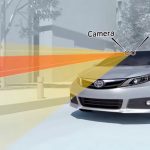Feeling Frustrated While Waiting at the Red Light
Enduring long waits at traffic signals can elicit an unpleasant feeling for drivers.
A recent study conducted in the UK revealed that waiting at red lights constitutes around one-fifth of the average person’s total time spent in traffic.
If the waiting time at red lights can be reduced, commuters in Asian countries can reclaim up to 75 hours per year for more productive endeavors.
Ford firmly believes that in the future, drivers can leverage cutting-edge technologies to minimize waiting time at red lights and optimize their time on the road. This technology holds immense potential in revolutionizing the daily commuting experience for Asian drivers, who often find themselves idling at red lights for up to 20 minutes.
The technology team at Ford is currently conducting tests on a vehicle-to-infrastructure (V2i) system that enables vehicles to connect with the traffic infrastructure. This groundbreaking technology is being piloted in various areas, including Shanghai. In these areas, the transportation infrastructure will share real-time traffic data with participating vehicles.
Thomas Lukaszewicz, Manager of Autonomous Vehicle Drive Technologies at Ford Motor Company in Europe and China, highlighted, “Imagine the transformative impact on your life without the need to spend time waiting at red lights. Vehicle-to-infrastructure technology has the potential to make your commute faster and more comfortable.”
Optimum Speed Advisory System
If implemented in the future, Ford will equip its vehicles with the Optimum Speed Advisory System (TLOSA). This innovative system will provide real-time traffic information regarding upcoming routes and recommend suitable speeds for drivers to maintain, thus reducing waiting time at red lights during their commute.
Ford’s test vehicles will be outfitted with reception and transmission devices inside the vehicle, which will relay TLOSA information to drivers through voice alerts or a display screen.
The TLOSA system relies on roadside monitoring devices and signal transmitters integrated into traffic lights and signs. These devices continuously gather and update traffic conditions at key intersections. Using this data, the TLOSA system calculates the optimal driving speed to minimize waiting time at red lights, ultimately streamlining your commute.
Through investments in the development of driver assistance technologies, Ford is dedicated to enhancing people’s quality of life. The TLOSA system, along with other technologies like parallel parking assist, lane-keeping assist, and speed control, showcases Ford’s unwavering commitment to fulfilling this vision.
Lukaszewicz shared, “We are confident that customers will embrace this technology. Consider the countless possibilities that could unfold instead of spending precious time waiting at red lights at intersections.”
If widely adopted, V2i technology has the potential to significantly reduce traffic congestion by intelligently regulating vehicle flow.
Lukaszewicz believes, “With the support of car manufacturers and road management agencies, this technology will bring immense benefits to commuters.”
anhduc_car (forum.autodaily.vn)














































![[Lexus RX 500h F Sport Performance Review: Astonishing Transformations]](https://vnauto.net/wp-content/uploads/2023/10/xehay-lexusrx500h-23062023-15-100x70.jpg)

![[CAR REVIEW] Ford Everest 2023: Leading the segment with confidence](https://vnauto.net/wp-content/uploads/2023/11/xehay-fordeverest-11042022-26-100x70.jpg)